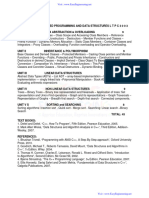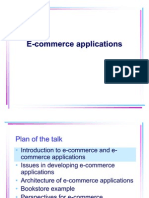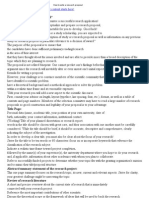ProgramPROGRAMMING AND DATA STRUCTURESming and Data Structures
Uploaded by
Suresh Babu C VProgramPROGRAMMING AND DATA STRUCTURESming and Data Structures
Uploaded by
Suresh Babu C VCS6301 PROGRAMMING AND DATA STRUCTURES II L T P C
3 0 0 3
OBJECTIVES:
The student should be made to:
Be familiar with the C++ concepts of abstraction, encapsulation, constructor, polymorphism,
overloading and Inheritance.
Learn advanced nonlinear data structures.
Be exposed to graph algorithms
Learn to apply Tree and Graph structures
UNIT I OBJECT ORIENTED PROGRAMMING FUNDAMENTALS 9
C++ Programming features - Data Abstraction - Encapsulation - class - object - constructors
static members constant members member functions pointers references - Role of this
pointer Storage classes function as arguments.
UNIT II OBJECT ORIENTED PROGRAMMING CONCEPTS 9
String Handling Copy Constructor - Polymorphism compile time and run time polymorphisms
function overloading operators overloading dynamic memory allocation - Nested classes -
Inheritance virtual functions.
UNIT III C++ PROGRAMMING ADVANCED FEATURES 9
Abstract class Exception handling - Standard libraries - Generic Programming - templates
class template - function template STL containers iterators function adaptors allocators
-Parameterizing the class - File handling concepts.
UNIT IV ADVANCED NON-LINEAR DATA STRUCTURES 9
AVL trees B-Trees Red-Black trees Splay trees - Binomial Heaps Fibonacci Heaps
DisjointSets Amortized Analysis accounting method potential method aggregate
analysis.
UNIT V GRAPHS 9
Representation of Graphs Breadth-first search Depth-first search Topological sort
Minimum Spanning Trees Kruskal and Prim algorithm Shortest path algorithm Dijkstras
algorithm Bellman-Ford algorithm Floyd - Warshall algorithm.
TOTAL: 45 PERIODS
OUTCOMES:
At the end of the course, the student should be able to:
Design problem solutions using Object Oriented Techniques.
Apply the concepts of data abstraction, encapsulation and inheritance for problem solutions.
Use the control structures of C++ appropriately.
Critically analyse the various algorithms.
Apply the different data structures to problem solutions.
TEXT BOOKS:
1. Bjarne Stroustrup, The C++ Programming Language, 3rd Edition, Pearson Education, 2007.
2. Mark Allen Weiss, Data Structures and Algorithm Analysis in C++, 2nd Edition, Pearson
Education, 2005
REFERENCES:
1. Thomas H. Cormen, Charles E. Leiserson, Ronald L. Rivest and Clifford Stein, "Introduction
to Algorithms", Second Edition, Mc Graw Hill, 2002.
2. Michael T Goodrich, Roberto Tamassia, David Mount, Data Structures and Algorithms in
C++, 7th Edition, Wiley Publishers, 2004.
CS6311 PROGRAMMING AND DATA STRUCTURE LABORATORY II L T P C
0 0 3 2
OBJECTIVES:
The student should be made to:
Be familiarized with good programming design methods, particularly Top- Down design.
Getting exposure in implementing the different data structures using C++
Appreciate recursive algorithms.
LIST OF EXPERIMENTS:
IMPLEMENTATION IN THE FOLLOWING TOPICS:
1. Constructors & Destructors, Copy Constructor.
2. Friend Function & Friend Class.
3. Inheritance.
4. Polymorphism & Function Overloading.
5. Virtual Functions.
6. Overload Unary & Binary Operators Both as Member Function & Non Member Function.
7. Class Templates & Function Templates.
8. Exception Handling Mechanism.
9. Standard Template Library concept.
10. File Stream classes.
11. Applications of Stack and Queue
12. Binary Search Tree
13. Tree traversal Techniques
14. Minimum Spanning Trees
15. Shortest Path Algorithms
TOTAL: 45 PERIODS
OUTCOMES:
At the end of the course, the student should be able to:
Design and implement C++ programs for manipulating stacks, queues, linked lists, trees, and
graphs.
Apply good programming design methods for program development.
Apply the different data structures for implementing solutions to practical problems.
Develop recursive programs using trees and graphs.
REFERENCE:
spoken-tutorial.org.
LIST OF EQUIPMENT FOR A BATCH OF 30 STUDENTS:
Standalone desktops with C++ complier 30 Nos.
(or)
Server with C++ compiler supporting 30 terminals or more.
You might also like
- Data Structures and Algorithm Analysis in C++, Third EditionFrom EverandData Structures and Algorithm Analysis in C++, Third Edition4.5/5 (5)
- Master of Computer Applications: Second Semester ExaminationNo ratings yetMaster of Computer Applications: Second Semester Examination11 pages
- Cs6301 Programming and Data Structures Ii: Unit I Object Oriented Programming FundamentalsNo ratings yetCs6301 Programming and Data Structures Ii: Unit I Object Oriented Programming Fundamentals1 page
- Department of Information Technology Vasavi College of EngineeringNo ratings yetDepartment of Information Technology Vasavi College of Engineering8 pages
- EC 2202 Data Structures and Object Oriented L TPCNo ratings yetEC 2202 Data Structures and Object Oriented L TPC2 pages
- 6-DSCs_UGCF_Multidisciplinary(2CD)_approved_facultyMay25-updatedNo ratings yet6-DSCs_UGCF_Multidisciplinary(2CD)_approved_facultyMay25-updated35 pages
- To Efficiently Implement Solutions For Specific ProblemsNo ratings yetTo Efficiently Implement Solutions For Specific Problems3 pages
- Important Questions & Answers Department of Computer Science and EngineeringNo ratings yetImportant Questions & Answers Department of Computer Science and Engineering176 pages
- Jawaharlal Nehru Technological University Anantapur: (9A05302) Advanced Data StructuresNo ratings yetJawaharlal Nehru Technological University Anantapur: (9A05302) Advanced Data Structures4 pages
- Data Structures and Object Oriented Programming in C++: RMKCET/COM/F-15No ratings yetData Structures and Object Oriented Programming in C++: RMKCET/COM/F-153 pages
- CS102 DICT2013 Fundamental of Data Structurr and AlgoritmNo ratings yetCS102 DICT2013 Fundamental of Data Structurr and Algoritm6 pages
- Anand Institute of Higher Technology KAZHIPATTUR - 603 103No ratings yetAnand Institute of Higher Technology KAZHIPATTUR - 603 1034 pages
- EC6301 Object Oriented Programming and Data Structure 1No ratings yetEC6301 Object Oriented Programming and Data Structure 1111 pages
- Co-Requisite: Prerequisite: Data Book / Codes/Standards Course Category Course Designed by ApprovalNo ratings yetCo-Requisite: Prerequisite: Data Book / Codes/Standards Course Category Course Designed by Approval4 pages
- Subject Outline - Data Structures and Algorithms - Autumn 2020 - UTSNo ratings yetSubject Outline - Data Structures and Algorithms - Autumn 2020 - UTS12 pages
- Dr. C.V. Suresh Babu: Seminar and Workshop SeriesNo ratings yetDr. C.V. Suresh Babu: Seminar and Workshop Series2 pages
- Dr. C.V. Suresh Babu: Seminar and Workshop SeriesNo ratings yetDr. C.V. Suresh Babu: Seminar and Workshop Series2 pages
- Use of ICT in Teaching, Learning and EvaluationNo ratings yetUse of ICT in Teaching, Learning and Evaluation18 pages
- T-11 Capstone Project Report: Group No: B43 Project Guide: Prof. Vinayak Musale Group Members SR No Name PRN NoNo ratings yetT-11 Capstone Project Report: Group No: B43 Project Guide: Prof. Vinayak Musale Group Members SR No Name PRN No16 pages
- Iustitia Dei A History of the Christian Doctrine of Justification 4th Edition Mcgrath - Download the ebook today and own the complete contentNo ratings yetIustitia Dei A History of the Christian Doctrine of Justification 4th Edition Mcgrath - Download the ebook today and own the complete content80 pages
- Two-Member QFX Series Virtual Chassis Upgrade Procedure: Network Configuration ExampleNo ratings yetTwo-Member QFX Series Virtual Chassis Upgrade Procedure: Network Configuration Example23 pages
- ANH102DE03 - ENGLISH LISTENING-SPEAKING 2 - HK2331 (Điều Chỉnh)No ratings yetANH102DE03 - ENGLISH LISTENING-SPEAKING 2 - HK2331 (Điều Chỉnh)17 pages
- Jenny Vee Isidoro: University of Santo Tomas-LegazpiNo ratings yetJenny Vee Isidoro: University of Santo Tomas-Legazpi2 pages





























































































